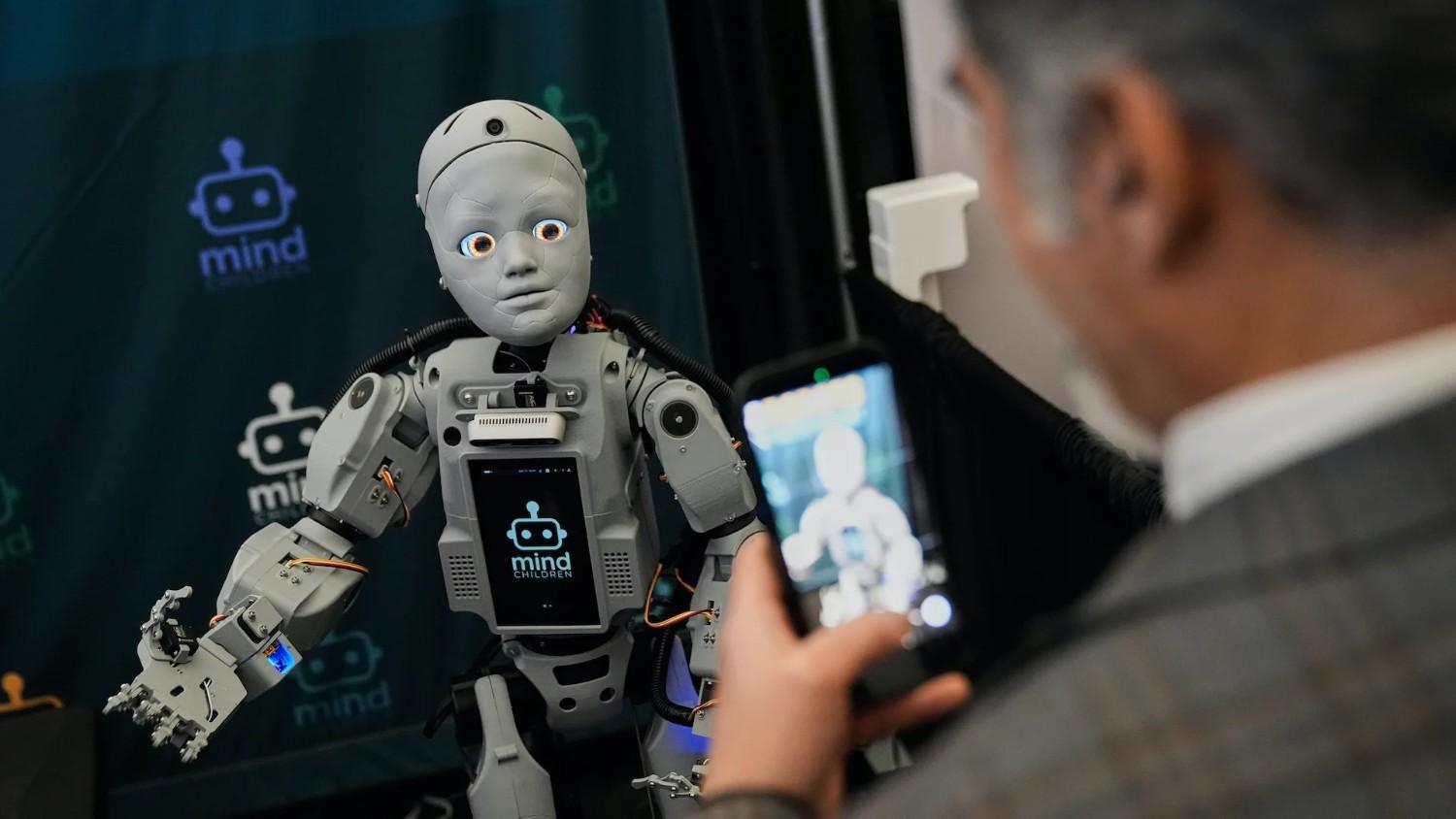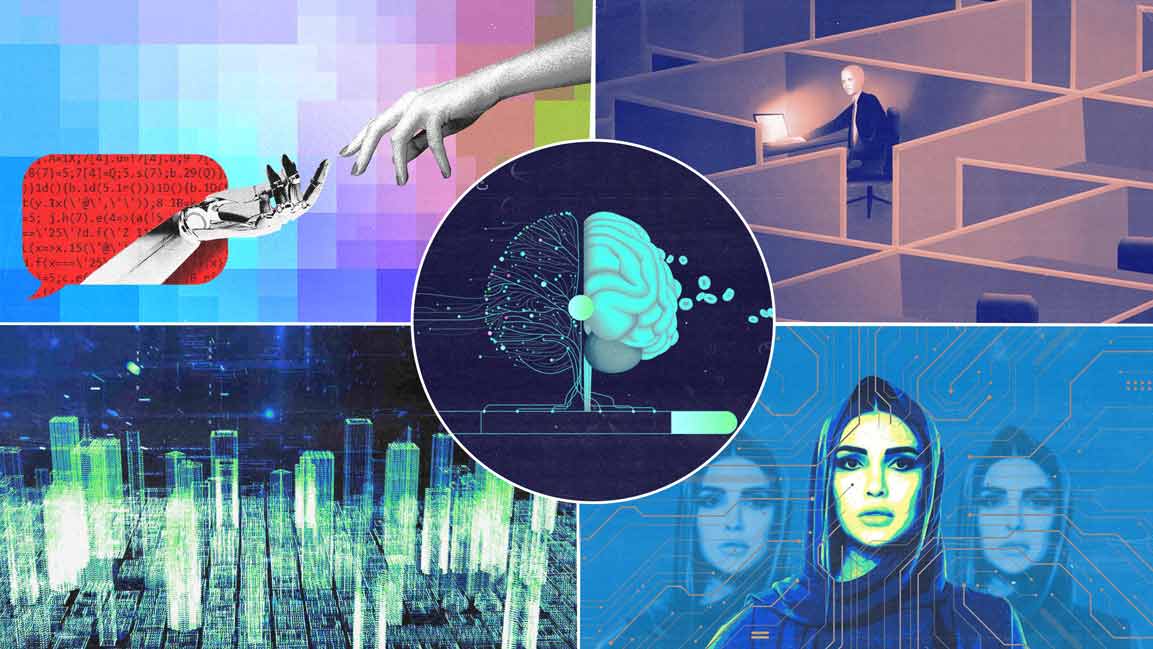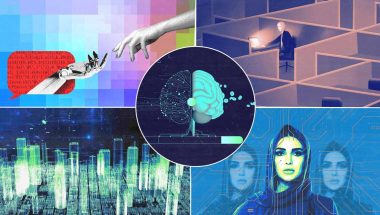- | 8:00 am
AI is here to save the metaverse
AI will inevitably play a huge role not only in the broader development of the nascent metaverse but also in regulating and democratizing it.

Robert Zubrin is a groundbreaking aerospace engineer best known for his contributions to the field of space propulsion. He’s also a loud and influential voice for interplanetary exploration and the eventual human colonization of Mars.
Across countless lectures, books, and articles, Zubrin has outlined the practical ways this colonization would occur. The first few missions would involve deploying infrastructure—habitats, factories, and food production facilities—eventually leading to the departure of the first Mars-bound pioneers. Initially, it would be a very lonely existence. Yet, over time, an entire society would emerge, develop, and prosper.
There are obvious parallels to the metaverse. By definition, the metaverse is a virtual world, where the mundane (work meetings or shopping) and the extraordinary (climbing K2 or chatting with Travis Scott) are possible. It’s an emerging technology, and the first cohort of early adopters are—in their own small way—pioneers. It’ll take time before a real, thriving metaverse community, or society, emerges.
And just as there’s no return flight from Mars, nothing physically keeps a user engaged in a metaverse experience. Thus the onus is on designers, developers, and agencies to create the interactive touch points that drive engagement, thereby giving the perception that the experience is vibrant and bustling with activity.
In practice, there are a few different ways brands and developers can accomplish this. The most obvious is through human agents—those employed to inhabit a virtual world and interact with visitors or potential customers, much like a cashier in a real-world retail outlet. The second involves leveraging generative AI to create human-like agents. These would provide users with a fulfilling experience, albeit at a fraction of the cost, and with the potential for large-scale developments.
The metaverse will always need a human touch. However, AI-powered agents will inevitably play a huge role at scale, not only in the broader development of the nascent metaverse but also in regulating and democratizing it. On the development side, it will allow for quicker, cheaper, and higher-fidelity art creation and deployment cycles. And on the channel management front, it will reduce long-term operating costs.
ARTIFICIAL STICKINESS
For marketers, success is defined by a number of metrics. Sales and revenue are important, but not exclusively so. Other concerns include brand awareness, brand perception, speed to market, and engagement—how long a person spends interacting with a brand. On these points, the metaverse shows incredible promise.
Take Celebrity Cruises Wonderverse, for example, which allowed visitors to explore a cruise ship from the comfort of their own homes. On its initial trial run, it saw an average of 28.5 minutes of dwell time. For a marketing campaign, this figure is nothing short of exceptional.
Another metaverse experience (created for Indian e-commerce giant Flipkart) saw 46% of visitors stay for more than an hour on average—again, an extraordinary figure that demonstrates what’s possible with enough resources. Flipkart and Celebrity Cruises are giants within their industries and can commit the funds and person hours to build metaverses that aren’t just ambitious but truly spectacular.
For similarly large businesses, AI can be a force multiplier, particularly when it comes to personalization. According to a 2021 McKinsey report, 71% of consumers expect brands to deliver personalized experiences, and 76% described feeling frustrated at cookie-cutter experiences. Brands that excel at personalization generate 40% more revenue than those that don’t, the consultancy firm also noted.
To deliver bespoke interactions, brands can combine these AI-driven agents with the data they hold on existing and potential customers, allowing them to align the user experience with the user’s own preferences—whether explicitly stated or inferred from their previous activity.
And while a human could engage based on what their CRM application says, a computer could do it cheaper, quicker, and with greater reliability. These personalized interactions will become even easier as companies adapt to the ongoing changes in the adtech industry, particularly when it comes to personal data.
The advertising industry is transitioning away from individualized cross-site and cross-application tracking systems (particularly the tracking cookie, which is set to be formally deprecated next year). As a result, brands will have to redouble their efforts to collect data about their customers directly, using only what they can see on their own products.
This first-party data (specifically, observations based on a user’s on-site activity) and zero-party data (which is provided directly and deliberately by the customer) will inform future marketing campaigns and likely inform how metaverse AI systems work. It’s easy to imagine a scenario in which a retailer uses sales, browsing, and biographical data to guide a virtual assistant’s interactions with a visitor to their metaverse experience.
This, in turn, makes the experience much more helpful and fulfilling to the visitor, and provides an impetus for further engagement.
HOW AI CAN ACCELERATE AND DEMOCRATIZE METAVERSE DEVELOPMENT
Metaverse development is undeniably expensive. Like video games, these environments are immersive and highly visual products that require a multidisciplinary development team of programmers, artists, and writers. Compounding matters, they have ongoing operational costs, as the experience needs to be staffed, maintained, and expanded throughout its lifetime. And I haven’t even mentioned the price of deployment, with virtual real estate and streaming often commanding steep prices.
For smaller companies, entering the metaverse is simply beyond reach. If we assume initial development costs between $500,000 and $2 million, and development timelines ranging from one to two years, it becomes apparent that an entire class of business is completely priced out of this sector. While AI isn’t a silver bullet for this problem, it can help reduce up-front and ongoing costs, making the metaverse more accessible.
Likewise, there are several apparent opportunities. The AI agents described earlier can assume the role of human employees, or augment a small team staffing a metaverse experience. They’ll help companies transcend budgetary limitations, allowing them to provide a white-glove experience around the clock, thus reaching customers and users in other regions and time zones.
Labor costs represent a significant portion of the ongoing costs of a metaverse product. If a company wants to staff its experience 24 hours a day, seven days a week, it will likely need at least five employees. Assuming each earns a salary of $60,000, we end up with a labor cost of $300,000 per annum.
While it might be impractical or undesirable to have a fully automated metaverse experience, it’s not inconceivable that a brand would choose to rely on AI during the experience’s quietest hours, allowing it to save on labor costs without also having to close its doors to visitors. There’s less likelihood of disruption caused by sickness or planned vacations, and the brand becomes more resilient to hiring difficulties—an ongoing problem in most industrialized countries.
AI will also play an essential role in the narrative construction of the metaverse. Generative AI products like ChatGPT have shown an uncanny ability to craft text to a variety of styles and about a variety of themes. For metaverse developers, its potential applications are vast, from responding appropriately to questions from visitors to crafting the language used in sprites, documentation, and other scripted elements of the experience.
Again, this won’t necessarily come at the expense of human employment. Someone will have to craft the prompts sent to the generative AI system and check the results for “correctness,” both factual and tonal. Additionally, any system used to respond to ad-hoc queries from users will need to be tested vigorously and refined before deployment. But even with those new tasks, it’s readily apparent how AI will help metaverse developers reduce costs and development time.
HOW THE METAVERSE CAN INFLUENCE AI DEVELOPMENT AND POLICY
Artificial beings are a common science fiction trope, exemplified by the likes of Star Trek’s Lieutenant Commander Data and Isaac Asimov’s Robbie. And they remain—at least for now—limited to the world of television, film, and literature. The technology required (particularly general AI, which remains purely theoretical) simply doesn’t exist.
Yet where these works of fiction agree is the potential societal and economic benefits of an automated human that can act like—but, crucially, isn’t—a human, and the need to create a series of rules and guidelines so that the technology can be used safely. Data famously couldn’t kill, and Asimov created the Three Laws of Robotics, which continue to influence AI policy and ethics.
The most serious works of science fiction often try to make earnest predictions about the future, whether through cautionary tales or utopian visions, and in doing so influence the present. But in reality, we can often really measure the impact of new technology only in hindsight. Once promising innovations—like leaded gasoline or Freon gas—have eventually come to be recognized as societal and environmental disasters.
In a recent article, Tom Wheeler of the Brookings Institution argued the need for strong rules for AI-powered metaverse agents to limit or, at the very least, mitigate any potential harm. Wheeler makes some salient (and perhaps even prescient) points, acknowledging the nuance between a simple video game and a metaverse, which by definition is a virtual world where people can interact, transact, and work.
The metaverse, he acknowledges, is really an AI-powered metaverse—where many of the characters and figures users encounter will be sophisticated machines that leverage the latest advances in generative AI. He recognizes that it will have a cross-demographic appeal, and there will be an urgent need from regulators and tech giants alike to ensure user safety, particularly when protecting individuals from harassment and abuse, and businesses from fraud and theft.
Wheeler correctly notes that the metaverse’s prominence (both societal and economic) means the old adage of “move fast and break things” no longer makes sense, and is likely very dangerous. Underlying his paper is a tone of urgency, which I share, but also pessimism, which I don’t.
Remember: The metaverse is designed to complement and augment the physical world. As metaverse adoption accelerates, it’s inevitable that many of the most exciting and promising advances in AI technology will be pioneered within virtual worlds before reaching other industries and the wider society.
As a lower (but not necessarily low) stakes environment, the metaverse is an ideal proving ground for many AI technologies, allowing developers to identify and remedy potential issues before widespread deployment. In that respect, metaverse developers and AI developers will eventually find themselves in a symbiotic relationship, each benefiting from the other’s success.
But that can happen only under the right regulatory environment. It’s incumbent upon legislators and developers to work collaboratively to find the right balance that allows innovation to progress unhindered while protecting users from potential harm.
NEW HORIZONS
Conceptually, while still in its infancy, the metaverse is a promising technology that’s set to radically reshape not only the internet but also our daily lives. And yet there’s still so much uncertainty, not just about timelines but also about how the mechanisms of this new digital ecosystem will work in practice.
We don’t know who the biggest players will be, whether any open standards will emerge (thus allowing for interoperability among platforms), and what platform will ultimately reign supreme. Or even if there will be a dominant platform.
Still, we can say with a high degree of certainty that AI will play an outsize role in the development of the metaverse, and vice versa. Artificial intelligence will be the rising tide that buoys all ships, both large (and cash-rich) conglomerates and plucky startups working from a shoestring budget.
For the largest brands and developers, AI will allow for the creation of ambitious, always-on, large-scale metaverse experiences. The same will be true for young startups, but they’ll also benefit from reduced development costs and a shorter time to market.
For many companies, AI will turn the metaverse from an ambition to something firmly within the realms of possibility. It’ll be a democratizing force, just like the Commodore 64 was for the home computer.
It’s also worth emphasizing that what I’ve described isn’t theoretical; it’s already eminently possible. Brands can already start building their own AI-powered agents by creating a custom system around an existing large language model like OpenAI’s GPT-4, or through an off-the-shelf solution like UneeQ’s Digital Humans. They can start using ChatGPT to craft the scripted parts of their experience, in turn allowing for richer and more expansive storytelling.
These tools are capable, and they’ll only get better over time. Just ask them.








































